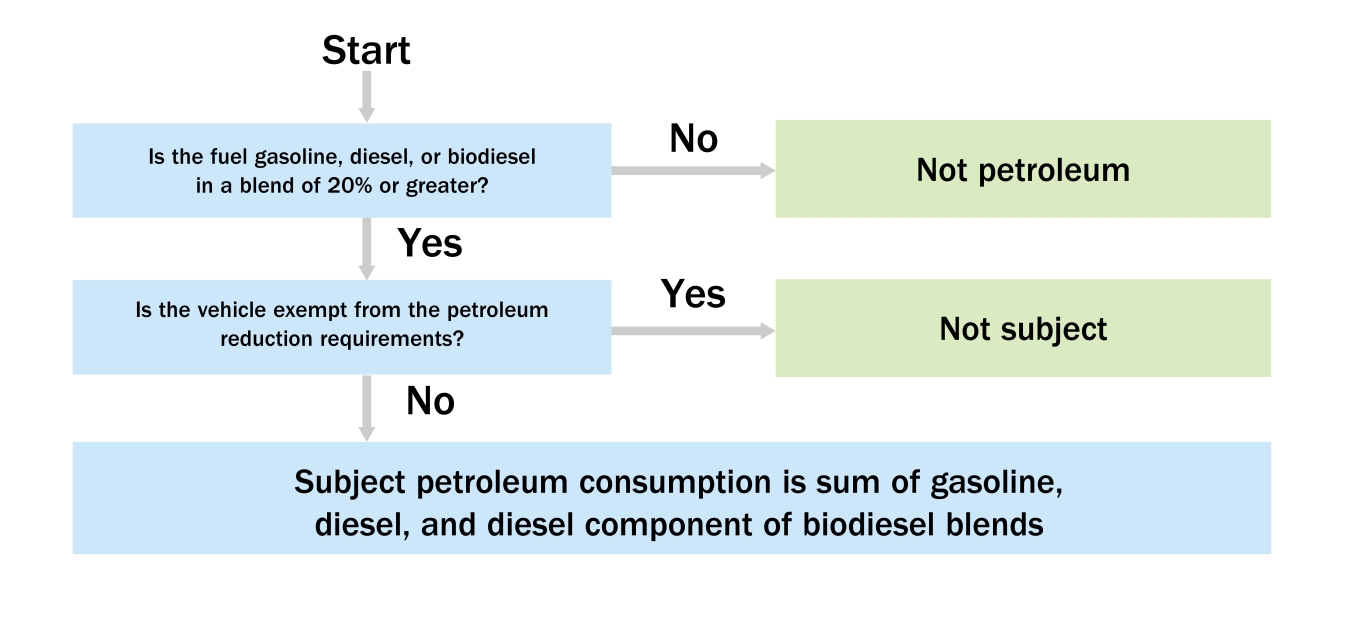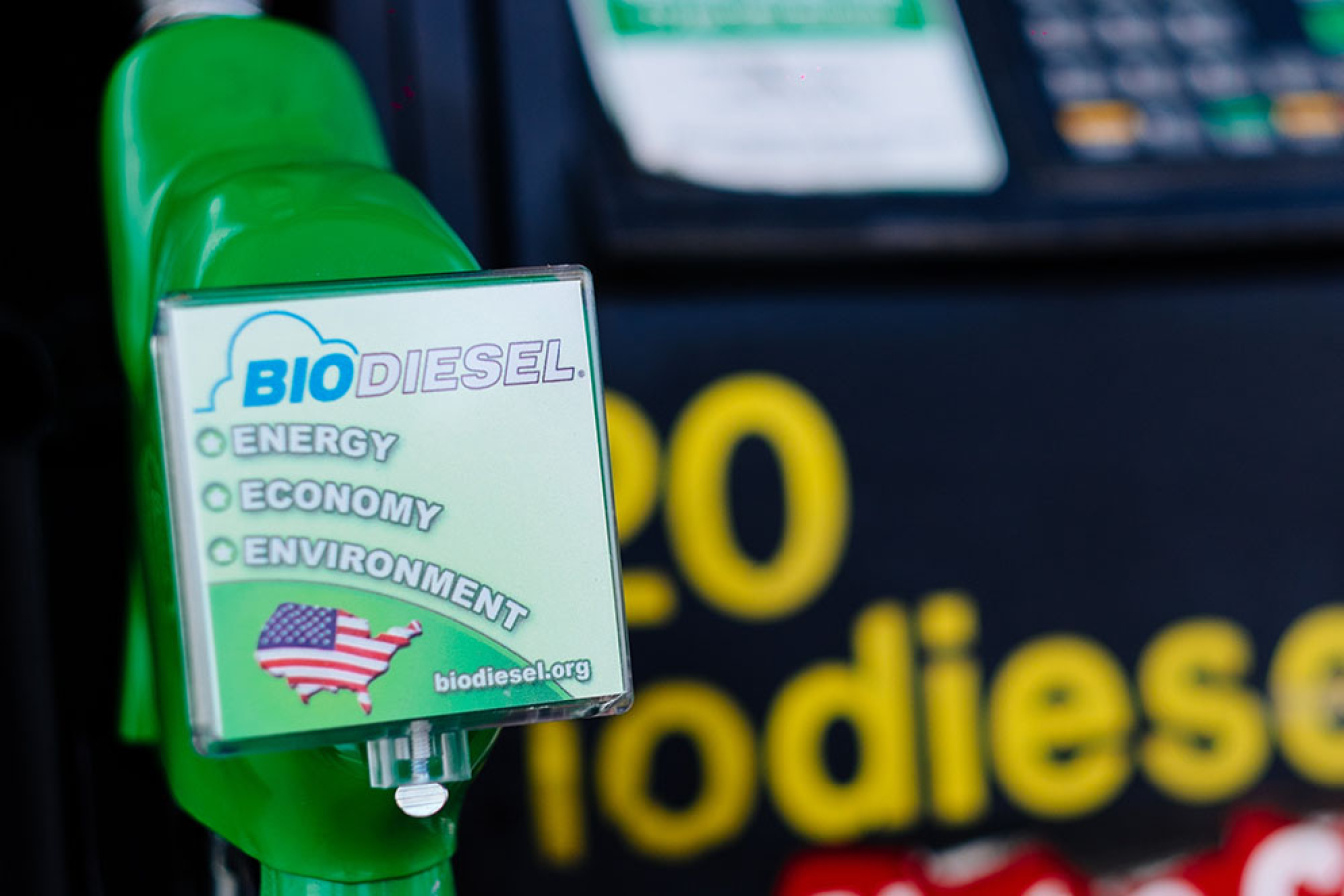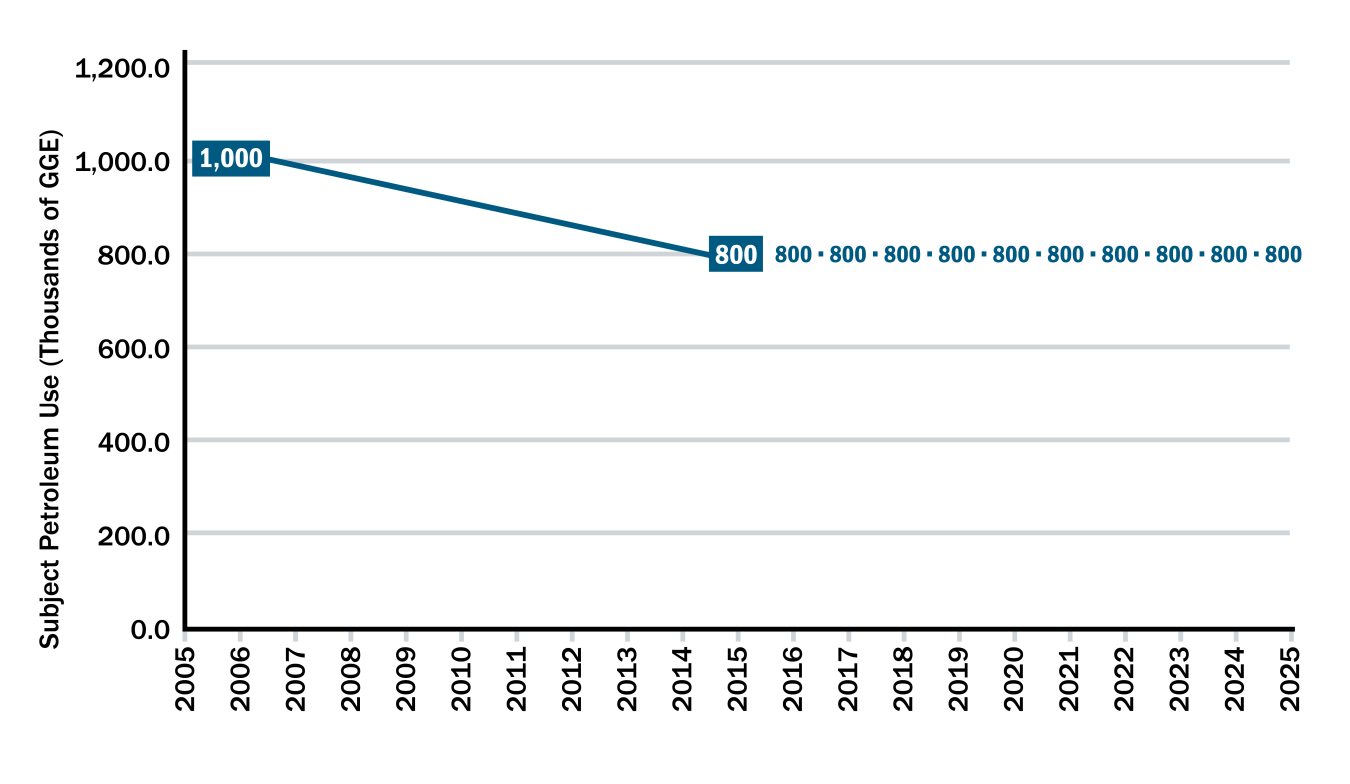EISA Section 142 Statutory Requirements for Petroleum Reduction
Section 142 of the Energy Independence and Security Act (EISA) of 2007 (42 U.S.C. § 6374e(a)(2)) says:
"[N]ot later than October 1, 2015, and for each year thereafter, each Federal agency shall achieve at least a 20 percent reduction in annual petroleum consumption and a 10 percent increase in annual alternative fuel consumption, as calculated from the baseline established by the Secretary for fiscal year [FY] 2005."
EISA Section 142 Applicability
The applicability of Section 142 of EISA is the same as EPAct 1992. See the Applicability page to determine which agencies and vehicles are subject to the EPAct 1992 requirements and which vehicles may be exempted.
FEMP Resources and Best Practices
Section 142 of EISA (42 U.S.C. § 6374e(a)(2)) requires Federal fleets to reduce their annual petroleum consumption by at least 20% compared to a fiscal year (FY) 2005 baseline by FY 2015 and for each year thereafter.
Calculating Subject Petroleum Use
Fuel that is counted in calculating subject petroleum fuel use includes:
- Gasoline fuel consumption in subject vehicles in the United States
- Diesel fuel consumption in subject vehicles in the United States
- Diesel component of biodiesel blends (20% or greater) used in subject vehicles in the United States.
Fuel that is not counted in calculating subject petroleum fuel use includes:
- Petroleum (gasoline, diesel, and the diesel component of biodiesel blends) used in exempt vehicles or outside the United States
- Alternative fuels used in both subject and exempt vehicles
- Biodiesel component of biodiesel blends (20% or greater) used in both subject and exempt vehicles.

Determining Fuel Counted Toward Subject Petroleum Use

Start with the volume of biodiesel blends used in subject vehicles. Multiply this volume by the percentage of the biodiesel blend that is diesel. For example, B20 is a blend of 80% diesel and 20% biodiesel. If a subject vehicle uses 100 gallons of B20, 80 gallons count toward subject diesel fuel consumption. The remaining 20 gallons count toward pure biodiesel consumption, an alternative fuel.
Petroleum use is measured in gasoline gallon equivalents (GGEs), which translate the energy content of fuel into units representing the energy content of one gallon of gasoline. The table below presents the fuel conversion ratio table to convert subject petroleum "natural" units to GGEs.
Subject Petroleum Conversion Ratio Table Fuel Type Natural Units Conversion to GGE B20 Gallons 1.121 GGE/gallon of B20 B100 Gallons 1.015 GGE/gallon of B100 Diesel Gallons 1.147 GGE/gallon of diesel Gasoline Gallons No conversion needed
Determining the FY 2005 Subject Petroleum Baseline
An agency’s FY 2005 petroleum baseline is simply the total petroleum used in all subject vehicles in an agency’s fleet as reported in Federal Automotive Statistical Tool (FAST) for FY 2005. This excludes fuel use by exempt vehicles (e.g., law enforcement and emergency vehicles). Note that some agencies have requested and been granted changes to their baselines by the Federal Energy Management Program (FEMP). These baseline revisions were granted based on documentation submitted by agencies supporting inaccuracies with FY 2005 subject petroleum consumption figures in FAST. Each agency should review its FY 2005 subject petroleum consumption figures currently in FAST for accuracy and, if this number is found to be incorrect, work with FEMP to determine its appropriate baseline.
Determining EISA Section 142 Subject Petroleum Reduction Compliance
To determine the subject petroleum use each year, agencies must sum together all types of petroleum fuel consumed by their subject fleet, including diesel used in blends of B20 or higher. The agency will then compare this to the subject petroleum fuel use requirement for that year to determine compliance.
Each Federal agency (subject to the petroleum reduction requirements) is in compliance if it reduces its annual subject petroleum use by at least 20% compared to a FY 2005 baseline by FY 2015 and for each year thereafter.
Example: Agency with FY 2005 Baseline of 1 Million GGE
The table and figure below show an example of an agency’s target subject petroleum reduction requirements relative to its FY 2005 baseline in compliance with petroleum reduction requirements of EISA Section 142.
| Calculation of Example Subject Petroleum Reduction Requirements Based on an FY 2005 Petroleum Baseline of 1 Million GGE | ||||
|---|---|---|---|---|
| FY | FY 2005 Petroleum Baseline (GGE) | Annual Subject Petroleum Fuel Use Reduction Requirement (Percentage of FY 2005 Baseline) | Required Reduction in Subject Petroleum from FY 2005 Baseline (GGE) | Maximum Subject Petroleum Use (GGE) |
| 2005 (Baseline) | 1 million | Not Applicable (Baseline) | ‒ | ‒ |
| 2015 | 1 million | 20% | 200,000 | 800,000 |
| 2016 and Onward | 1 million | 20% | 200,000 | 800,000 |
Example: Subject Petroleum Use Requirements Based on an FY 2005 Petroleum Baseline of 1 Million GGE
Agencies should specify the percentage and amount of petroleum they plan to reduce in the coming year and the percentage and amount of petroleum that they reduced in the prior year in an annual Sustainability Report and Implementation Plan.
Reporting
To track compliance with the EISA Section 142 petroleum reduction requirements, Federal agencies are required to collect and report accurate annual vehicle fuel use data in FAST. These data will be used in FAST to automatically calculate annual compliance with the EISA Section 142 subject petroleum reduction requirements. Fleets must input annual vehicle data into FAST each year; the reporting period begins on roughly October 1 and closes in mid-December.
Agencies are required to collect and manage annual asset-level data (ALD) (per vehicle rather than aggregated fleet data) in a formal agency fleet management system, and submit relevant data managed in that system to FAST. Agencies must upload vehicle ALD from their fleet management system to FAST using a standardized file structure, which includes vehicle inventory, acquisition, cost, mileage, and fuel use information for each vehicle. Agencies should ensure the required asset-level information in their fleet management system is finalized and reported to FAST well in advance of the mid-December deadline. Timely reporting will allow agency headquarters personnel ample opportunity to review the data for completeness and accuracy prior to final submission.
FEMP Best Practices: Four Core Principles of Sustainable Fleet Management
An agency can reduce its fleet’s petroleum consumption through the appropriate combination of the four core principles of sustainable fleet management:
- Right-sizing fleets and vehicles to missions
- Reducing VMT and idling
- Increasing fleet fuel efficiency
- Increasing use of alternative fuels (including biodiesel blends) and electricity (through deployment of electric vehicles and related charging infrastructure).
Read more about the four core principles of sustainable fleet management. Agency fleet managers should evaluate petroleum reduction strategies and tactics for each fleet location based on an evaluation of site-specific characteristics, including availability of alternative fuel, fleet size, and fleet vehicle composition.


